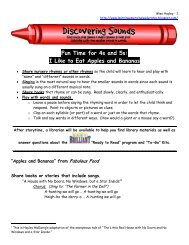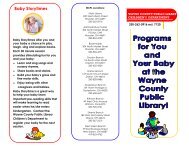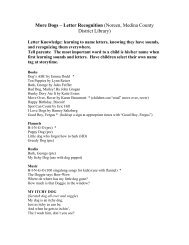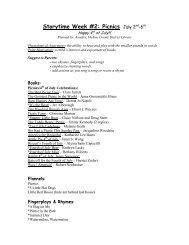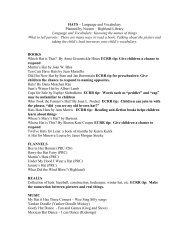presentation script - Ohio Ready to Read
presentation script - Ohio Ready to Read
presentation script - Ohio Ready to Read
Create successful ePaper yourself
Turn your PDF publications into a flip-book with our unique Google optimized e-Paper software.
Awareness (understanding that print is everywhere, that letters and words have meaning, and learning<br />
how books work), Print Motivation (the interest in books and reading), Vocabulary (learning new words),<br />
Narrative Skills (understanding the parts of a s<strong>to</strong>ry), and Letter Knowledge (knowing the ABC’s). This<br />
may sound like a lot of skills for a six-year-old <strong>to</strong> learn, but these are things that can be easily taught<br />
through play, and children at this age are eager <strong>to</strong> learn anything you want <strong>to</strong> teach them!<br />
Some of the resources we have at the library include handouts with suggested activities, computer<br />
games that cover all six skills, and <strong>to</strong>ys that reinforce reading readiness. We even have backpacks filled<br />
with <strong>to</strong>ys, games, books, and CD’s that are tailored <strong>to</strong> fit each skill. (Show example backpack and explain<br />
how the items inside fit with the particular skill.)<br />
Recently, the State Library of <strong>Ohio</strong> has provided libraries with copies of the book You, Me, and the ABC’s<br />
by Michael J. Rosen. This book is full of activities that a parent can do with their child <strong>to</strong> jumpstart their<br />
reading career.<br />
There are two things <strong>to</strong> keep in mind while using this book with your child. First, learning literacy skills<br />
should be FUN. Never force your child <strong>to</strong> work on a certain skill as though they are in school. This is not<br />
lesson time, it is play time. Kids should view word and letter activities like any other game or <strong>to</strong>y.<br />
Making learning time and play time makes sure your child will want <strong>to</strong> learn and will learn more.<br />
Secondly, the activities in this book are just a starting point. In order for early literacy play <strong>to</strong> work, it<br />
must become part of your everyday routine. Think about your day and how busy you are. If you try <strong>to</strong><br />
fit half an hour of “lessons” in that cover letters and words, you will soon become frustrated and<br />
discouraged. Instead, incorporate letters and literacy in<strong>to</strong> the things you already do. Chances are, you<br />
are already doing many things that help prepare your child for reading. You, Me, and the ABC’s will just<br />
give you some new ideas <strong>to</strong> incorporate literacy in<strong>to</strong> your life.<br />
So, let’s start with the beginning <strong>to</strong> our day—breakfast. Turn <strong>to</strong> pages 10 and 11 in your copy of You,<br />
Me, and the ABC’s. How easy is it <strong>to</strong> go <strong>to</strong> the s<strong>to</strong>re and buy some generic alphabet cereal? As soon as a<br />
<strong>to</strong>ddler can pick up a piece of cereal, he or she can be learning the letters in his or her name! Even if<br />
they can’t answer back, you can still point out their first initial in their cereal, on street signs, in the<br />
newspaper, even on your cell phone! Usually, the first letters children learn are those in their name,<br />
and it is also usually the first word they learn <strong>to</strong> recognize on paper. Notice that every page in the book<br />
has both a capital and lowercase letter. It is important for children <strong>to</strong> learn both sets of letters for<br />
reading readiness. All of this, of course, leads <strong>to</strong> our skill Letter Knowledge. And, for a bonus, if you talk<br />
about the sounds a letter makes that’s Phonological Awareness.<br />
Let’s talk about Phonological Awareness for a second. This tends <strong>to</strong> be the hardest skill for a lot of<br />
children. This is one skill that can start from birth and really evolve through a preschooler’s<br />
development. The best thing you can do with a child <strong>to</strong> increase Phonological Awareness is <strong>to</strong> sing. The<br />
notes of a song naturally break up words in<strong>to</strong> syllables that are easily distinguished. Think about<br />
“Twinkle, Twinkle, Little Star.” (Sing song even if you have no singing voice and clap on each beat <strong>to</strong><br />
show how each syllable has its own note.) Don’t worry if you can’t sing. I’m willing <strong>to</strong> bet that many of<br />
you want <strong>to</strong> cover your ears when your preschooler sings in the car, right? Totally <strong>to</strong>ne deaf! But sing



